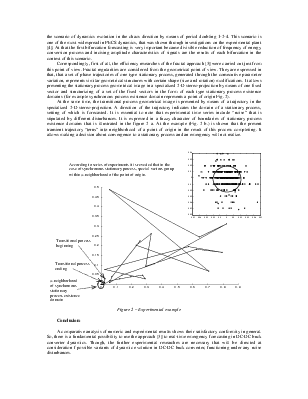



AMERGANSY FORCASTING IN DC-DC BUCK CONVERTER DYNAMICS
Andrey. О. Kozel, Denis. V. Demkin, Evgeniy. A. Godovnikov
5, Naygorskoye Shosse, 302020, Orel, Russia;
Department of Design and Technology of Electronic Systems
State Technical University of Orel,
29, Naygorskoye Shosse, 302020, Orel, Russia.
tel: +7 (4862) 421661, fax: +7 (4862) 416684, e-mail: andreyk_deva@mail.ru
Abstract – Pulse energy conversion system (PECS) safe and reliable operation depends on timely forecasting of emergencies, which are connected with PECS dynamics evolution in the direction of undesirable dynamic regimes (such as sub-harmonic, quasi-periodic and chaotic processes). The experimental investigation results, the purpose of which was an estimation of possibility of practical usage of an approach to real-time emergency forecasting in PECS dynamics are presented in the paper.
Introduction
At the present, a pulse mode of energy conversion is recognized one of the promising power-saving technologies and widely used in industrial production (for example, in municipal economy systems, chemical production, nuclear power, electric transport, computer system power supplying at any levels of information structures and so on). At the same time, the possibility of dynamics evolution processes is recognized by experts in fields of PECS design and operation [1, 2]. In these cases, functioning regimes different from an operational one settle in PECS dynamics and the converted energy qualitative and quantitative characteristics change.
The reasons of PECS possible dynamics variety are stipulated by both PECS mathematical model considerable nonlinearity (a piece-smooth system with nonlinear elements in the structure) and PECS functioning under the condition of different probable factor actions on dynamics, such as system degradation in time, external disturbances (first of all, owing to variation of actual temperature and parameters of entrance energy), the initial deviation of PECS element values regarding its nameplate data, and so on.
Stability loss of the operational regime (synchronous stationary process) is the first sign of abnormal phenomena appearance in PECS dynamics. So, both safety and reliability of PECS functioning depend on timely forecasting of these situations (emergencies). Correspondingly, an approach to PECS dynamics forecasting seems to be one of the promising perspectives, if it allows making a correct decision on the next stationary process in PECS dynamics before this process have settled. Just from this point of view, the requirement to real-time dynamics forecasting implementation hereafter will be considered. This paper is devoted to an estimation of the practical usage possibility of one of the approaches to the identification and to the real-time emergency forecasting in PECS dynamics that was considered in [3]. The experimental plant of the DC-DC buck converter is used in this research. The description of the experiment plant is considered in chapter 1. In chapter 2 the points of the approach is briefly presented and experimental research results are given.
1 Experimental plant
The experimental plant on the basis of the DC-DC buck converter [4] was taken as the prototype that was improved with the purpose of the experimental investigation of the identification and of the real-time emergency forecasting in PECS dynamics. The experimental plant improved was designed according to the modular structure that allows making suitable changes in case of necessity. It is made of the following six basic functional parts (Fig. 1): control subsystem, power stage, IBM-PC with analog-digital converter board (ADC), auxiliary power supply, 3-chanal data acquisition and data processing subsystems. The control subsystem realizes control algorithms of the power stage key elements according to the manner of pulse-width modulation of an energy flux and realizes proportional (P), proportional-integrational (PI) and proportional-derivational (PID) control modes.
Then the power stage operation principle is
the following: the power stage output voltage by means of a voltage sensor is
transferred to a compensator where reference voltage is subtracted from it. The
control error acquired is transferred to the control mode given, and by means
of the pulse-width modulator transformed to a pulse pattern with a fixed
frequency and periodic (for stationary processes) or non-periodic (for transient
or chaotic processes) duty. The pulse pattern is transmitted to a driver. The
driver forms voltage levels, which are necessary to control the power stage
transistors (S1 and S2). The transistors function in anti-phase mode and
combine into synchronous voltage converter. Parameter variation is realized by a
program, in particular, transfer constant of the proportional unit and load resistance
during experiments were being changing by the control  program. This program changes digital code from
LPT-port of IBM-PC.
program. This program changes digital code from
LPT-port of IBM-PC.
The data acquisition subsystem realizes intelligent signal processing that comes from the three synchronized canals: two voltage signals and current signal. The signals transformed from the data acquisition subsystem can be transmitted to fast signal processing and slow signal processing. Fast signal processing is realized with the help of the data processing and control subsystems. First of all, algorithms of time series processing are directed to real-time emergency forecasting in DC-DC buck converter dynamics, including widely used algorithms processing such as Fast Fourier Transformation (FFT) and realized in data processing subsystem.
Уважаемый посетитель!
Чтобы распечатать файл, скачайте его (в формате Word).
Ссылка на скачивание - внизу страницы.